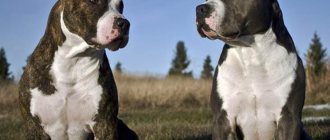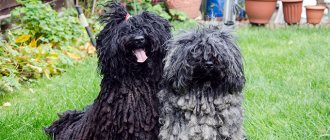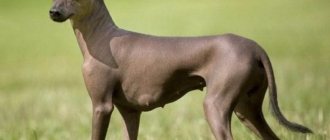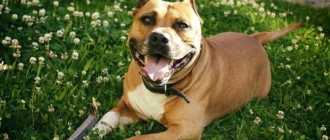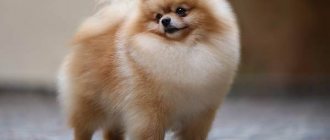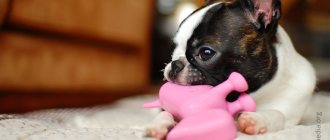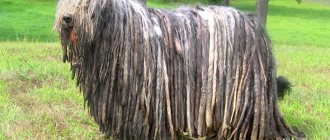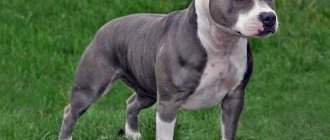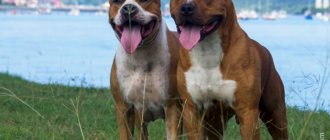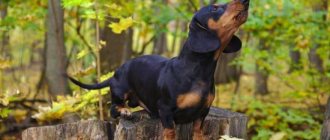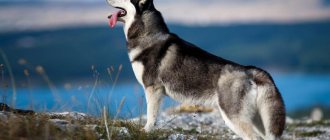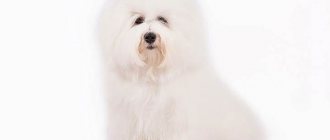According to historical data on the origin of different breeds, fighting dogs do not have a single ancestor. According to the classification, they all belong to the Wolf family and, according to one version, they descended from wolves and jackals. Through selection and production of hybrids, fearless pets were bred, capable of quickly entering into battle, protecting themselves and loved ones, and fighting for their owner.
Dogs took part in gladiator fights, accompanied people on campaigns, and were an integral part of attack tactics and territory protection.
In ancient times, Molossians were valued; in the Middle Ages, bulldogs appeared, then a group of terriers appeared. In the last two centuries, history has allowed the possibilities of interbreeding to expand. Representatives of herding groups and typical hunting dogs joined the fighting dogs.
At the same time, hybrid forms of breeds acquired their final features. This was facilitated by the organization of exhibitions and other events, and the development of special international standards.
There is no single definition of “fighting dog” in the world; it is very conditional. This includes those representatives who, based on their character traits, abilities, learning ability and appearance, are suitable for being allocated to groups.
Dogs are reliable guards and defenders with a special character, where the leading feature is innate aggressiveness. During the selection process, the ability to quickly attack and attack decreased. This does not mean that all Wolfs have turned from fighting pets into good-natured people.
We must always remember that behavioral traits and characteristic features are inherent in many people. How they will manifest themselves, when, why, no one knows. Owners should be properly trained, taking precautions, and suppressing the pet's desire to take a leading position.
Classification of fighting dog breeds
When selecting Volchis for a group, they are still guided by several factors:
- Strong paws, large head and developed jaws.
- The body structure is powerful, allowing it to withstand physical stress.
- Most fighting dogs have close-fitting fur. A specific feature is stretching, which minimizes injuries.
- Basically all breeds are smooth-haired. The exception is dogs, which were originally intended for hunting. Their hair is fluffy, with a rich undercoat.
The classification involves division into groups based on origin. These include:
- bulldogs;
- mastiffs;
- terriers;
- shepherds
There are also representatives who do not belong to any of the groups due to the characteristics of their origin.
Due to different characteristics, they are divided into groups by size (small, medium, large) when the height of an adult dog is determined. Another classification is wool (short, medium, long). Some have several subspecies of wool at once, which allows them to withstand weather loads of varying intensity.
Bull Terrier
A compact but very strong dog with a well-deserved reputation as a killer. With a height of 30–40 cm at the withers and a weight of only 13 kg, the Bull Terrier will emerge victorious in a fight with almost any opponent.
A unique feature is a complete set of teeth. Total 42: 20 on the upper jaw, 22 on the lower jaw. The normal force of jaw compression is approximately 1100 N, but appropriate training allows you to increase it to 1450 N. At the same time, the bull terrier holds the record for the duration of a bite: it is capable of holding a victim for up to three hours.
Tough in battle. He does not strive to finish off the enemy as quickly as possible. Before killing, the bull terrier inflicts multiple wounds so that the enemy bleeds, tries to gnaw the carotid artery or jugular vein.
TOP fighting dog breeds
We present the most popular breeds that are classified as “fighting dogs” based on certain qualities.
Terriers
Terriers are a large group of wolves that were originally bred to hunt animals. Translation from French means “burrowing dog.” These are ancient representatives with a developed instinctive sense, brave disposition, and stubborn character. Among them there are large individuals. Fighting dogs have genes from bulldogs in their blood, which makes them more aggressive.
Bull Terrier
It is distinguished by an interesting skull structure with an elongated muzzle, which smoothly transitions into the forehead with a large bridge of the nose. The eyes are set on the sides. The overall appearance is terrifying. Height reaches no more than 40 cm in males. Compact, well-muscled, bull terriers require constant training. They treat pets and their family well, but they have difficulty getting along with other pets. They are characterized by jealousy, intolerance, and the likelihood of a quick attack without reason.
Staffordshire Bull Terrier
Bred by selection among the best among terriers, molossers and bulldogs as a dog participating in fights. Strong paws and stability help to attack quickly and fight to the last. As selection progressed, the character was softened, but genetically they are real fighters.
Some may find them too cute, but most will agree that the beast is dangerous. They have rich facial expressions, an attentive gaze and a stubborn character. When training, you need to suppress the desire to take leadership positions. These are small dogs that are convenient to keep in an apartment, but they need to go for walks and engage in physical activity due to their tendency to become obese.
American Pit Bull Terrier
Daughter type of Stafford. After dog fighting was banned in England, pit bulls appeared in the United States. They were considered the most improved breed, from whose blood fabulous money was earned. Outwardly they are similar to bulldogs and terriers, but with a more powerful muscular body and strong limbs.
Due to the lack of international standards, there is no clear definition of height. It can reach up to 53 cm, but there are individuals 43 cm. Today it is prohibited in many countries of the European Union and America. They are considered potentially dangerous dogs that show uncontrollable aggression. The owner who is going to raise a pit bull must be aware of the responsibility for the behavior and options for attacking other dogs.
American Staffordshire Terrier
The next generation after pit bulls. It is included in the international register and has the right to participate in exhibitions. With a softer, flexible character, but with fighting qualities. Loyal to the owner and family, amenable to training. The ears are cropped, unlike Stafbulls. Strong, hardy, muscular and stately.
Always ready to fight. Excellent obedience is the result of impeccable work with the owner. The breed is suitable for those who love physical activity and want to have reliable protection for their home and family.
Mastiffs (Molossoids)
Representatives of an ancient group, specially bred for gladiatorial combat, participation in battles, baiting large animals, and long-term pursuit of prey. They belong to the mastiff-like dogs. Outwardly they seem imposing, calm, dependent on a person - this is the result of excellent maintenance. They are naturally endowed with the ability to take part in battles and the ability to stand up for themselves, so they cannot be called a simple breed.
Character of mastiffs
One of the negative traits of Molossoids is stubbornness. You will have to exert maximum patience to overcome the desire to dominate. They are great with children. The owner will constantly feel the presence of the dog nearby. They are sensitive, attentive, inclined to evaluate the world around them, and lazy. They give off a feeling of peace that quickly breaks down alertness.
Molossians have a quick reaction. Its impressive size allows it to lunge and knock down the enemy. The powerful jaw causes wounds. The body is massive with well-developed limbs and strong muscles.
Without proper training, they turn into uncontrollably aggressive dogs capable of attacking without warning.
English Mastiff
The largest of all European mastiffs. Weight more than 100 kg, height up to 75 cm - something that inspires fear and respect. Outwardly it resembles a pug with a dark muzzle and light beige body, paws and tail. The folds and drooping jowls are especially similar, but the nose is more elongated with a large black lobe. Used as baiting dogs. Today they are peaceful guard dogs if raised with love and care.
Bullmastiff
The result of crossing an English mastiff and a bulldog to protect forest lands from robbers. Capable of attacking a person and causing injury (even death). The muzzle is similar to that of a bulldog with deep wrinkles. The body is well developed, muscular, strong. The skull is wide, the ears droop, which are not shortened, like the tail.
His height is about 70 cm and his impressive body allows him to make high jumps and develop fast speed when running. A devoted dog for a family with children, guards and is able to quickly fight in case of danger.
American Bandog
By origin, it is determined by the cross breed of the Neapolitan Mastiff and the American Stafford for night guarding the territory. Not recognized by international canine organizations. On average they reach 40 cm and 45 kg. weight. The coat color is black with a white stripe along the sternum, passing to the stomach. Dark color options are available. The skin stretches well, which helps to avoid severe injuries during battles.
Due to uncontrolled crossbreeding, breeders have never bred a more docile dog. They are cruel, aggressive, and difficult for a dog breeder without experience working with such representatives to handle.
Bully kuta
A rare breed for Europe, it was bred in Pakistan. The literal translation of the name is “heavily wrinkled,” which is due to the typical folds on the muzzle. They are characteristic of molossoids. Height up to 86 cm. The physique is strong and strong. Used for security. They do not tolerate children or other people. They require constant training and intense physical exercise.
Dogue de Bordeaux
French dog for guarding and carrying heavy loads. They have moderate aggressiveness. Bordeaux are distinguished by a red color of the body, limbs and a darker muzzle. The head is large, there are folds on the muzzle, massive jaws. The ears are not cropped.
They tend to treat younger family members with care, provided they are raised. Tolerant of other pets, needs exercise. It became a popular breed after the release of the film “Turner and Hooch,” which showed the peculiarities of dog training.
Ca de bou
A short mastiff designed for baiting hunting. Originally from the Balearic Islands. They were intended for protection and work “in a team” with other animals. They do not try to attack first. They are considered good-natured helpers and protectors of the territory. They never show aggressive traits. They like it when the owner pays attention and care. They respond with gratitude and are well trained.
Cane Corso
Called the pride of Italy. A typical representative of guard, fighting dogs, although at first they were used for driving livestock. Height up to 68 cm, long paws, stately body - something that inspires confidence. The dog looks beautiful, but fierce. They love to be close to humans. They treat other pets favorably, make friends in the “dog playground,” and do not enter into conflicts. They perform excellent search service and protect the territory.
Tosa Inu
A slender torso is not a typical feature for a mastiff. The dog was bred in Japan for protection. Long limbs and a muscular body allow them to withstand physical activity. There are almost no folds on the muzzle, but the general appearance is similar to the group. They are considered a difficult breed to train, when overcoming stubbornness will require enough time and the attentive attitude of an experienced dog handler.
Fila Brasileiro
Slightly smaller in size than the English Mastiff, so similar in appearance that it can be confused. The birthplace of the breed is Brazil. A distinctive feature is the massive numerous folds on the neck due to the structure of the skin. Does not tolerate strangers, immediately shows a negative attitude towards others. For the home, this is a good guard dog that loves its family. Does not like active activities, lazy, unhurried.
Shar Pei
This dog has two distinctive features: many skin folds and a tongue with dark pigmentation. Today it is perceived as a decorative dog, although it is a serious dog with protective qualities. Getting into a fight is a matter of honor for a Shar Pei. They have high intelligence, understand words and gestures, and are trainable. Socialization must begin early, demonstrating the superiority of humans over pets.
Mountain herding dogs
Initially, the breeds were intended to help shepherds. Later, due to their excellent protective qualities and special anger, they began to be used to participate in dog fights, which were nevertheless banned. They are difficult to educate and stubborn. Due to the wool cover, they are resistant to weather changes.
Alabai
Related to Molossians. There have been virtually no modifications in the breed. In ancient times, she took part in gladiatorial battles. Externally it looks like a bear, copes with heavy loads. The torso is powerful with a developed sternum and limbs. Tall growth, thick undercoat, strong grip distinguishes it from its relatives. Growing up is later, so the behavior of puppies and juniors can be traced. It's very difficult to raise. They go into battle without fear, show intolerance towards other breeds, and are difficult to socialize.
Gampr
Armenian wolf dog with a stately exterior. The large size of the dog inspires fear. There is a black mask on the muzzle, sand-colored fur on the body, and a crocheted tail. Like the alabai, they are distinguished by their late maturation. They are devoted to their owner if they feel power and attention. Character is strong and stubborn. They are great with family, but do not tolerate others, especially strangers. Serves as protection and protection.
Caucasian Shepherd Dog
An ancient Caucasian breed with three subspecies, differing in coat length (short, intermediate, long). They are considered representatives of corpulent shepherd dogs for guarding and protecting the home and family. Instinctively able to quickly respond to extraneous sounds and rustles. They treat their family with attention if they feel love and patience. The stately breed requires constant training and plenty of time for walks and games.
Bulldogs
Species representatives appeared by crossing the best subspecies of mastiffs, pugs, and greyhounds. As a result, they were used as hunting animals for baiting animals and as participants in dog fights. Security abilities were later noted. All of them have specific muzzle characteristics: a short, upturned nose, floppy ears, round eyes and short hair.
A group of bulldogs have widely spaced, strong paws. They tend to be overweight, unhurried, and relatively calm. They have a positive attitude towards children and love them, and are considered companion dogs. They love attention and cannot stand excessive severity. They can be aggressive towards other pets.
English bulldog
Appeared earlier than others. He seems to completely repeat the famous stiffness of the inhabitants of Foggy Albion. The height reaches 40 cm. The fur fits tightly to the body, molting goes unnoticed. They are prone to obesity and prefer a sedentary lifestyle. They love leisurely walks. We must always remember that they were traditionally used for baiting animals; they can make aggressive attacks.
American Bulldog
The most serious of all the mixed breeds of the bulldog group. There is no pug blood in it, it is larger and more massive. Constantly subjected to changes to obtain better qualities. The selection of calmer, less aggressive dogs led to the results of the fighting dog becoming a family pet.
Blood from a mastiff reveals a typical representative: a large head, a powerful body and long limbs. They have a special jaw grip. When raising, you need mental stability and firmness. Their intelligence is highly developed. Selection is still being carried out.
French Bulldog
Small size. The height does not exceed 35 cm. High-set ears, an upturned nose, and a flattened muzzle with wings give the dog a comical appearance. The limbs are short, the body is dense. They are able to run fast, catch up with prey, and play. They do not tolerate other Wolfies, they need early socialization. They love children. The character is flexible, but there is a share of stubbornness and willfulness. They are bred as decorative dogs. They are often taken by bulldog lovers to small apartments.
The concept of “fighting dogs” and why it is not entirely correct
The category of fighting dog breeds is not recognized by any cynological organization. This colloquial concept is used only in everyday life, referring to the distant past of some quadrupeds.
Historical reference
England is recognized as the birthplace of dog fighting, although it has been known since the times of gladiators. In the 18th-19th centuries, many bloody tournaments between terriers and bulldogs were held here. Betting on such dubious sports was popular among London's poor.
The most ferocious and courageous dogs were selected to participate in battles. For the sake of victory, breeders focused exclusively on aggression. Four-legged pets were pitted not only against each other, but also against other animals: rats, bulls and bears.
After the ban was introduced, former champions had to be re-educated. Breeders managed to change their character. Most of the bloodthirsty dogs have become completely harmless companions or faithful guards.
Animal format
In the 21st century, fighting breeds include dogs with large dimensions, developed jaws and good endurance. Participation in dog fighting on the part of the ancestors is encouraged, but is not required for inclusion in this group. Because of this, not only terriers and bulldogs, but also molossoids, shepherd dogs and other animals fall under the format.
Please note that not only the concept itself is erroneous, but also its use. Dogs can only be fighting dogs, not fighting dogs like the world famous club. But for the sake of simplicity in this article, both options will appear in it.
Other fighting breeds
Among other dogs, there are those whose fighting character automatically classifies them into the group, but does not distinguish them into a specific subspecies.
Akita Inu
The dog comes from Japan with a high head, long legs and a cute face. Looks like a fox or smiles all the time. An excellent breed for protection, although it looks like a toy. Obedience training should be done by someone who is able to overcome an Akita. They need constant training and classes. If they are bored, they can start a fight and enter into battle.
The increased level of aggressiveness is explained by the dog’s original purpose for hunting and protecting livestock, accompanying people on long journeys. He is friendly with the owner and does not interact well with other dogs.
American Akita
A variety of Japanese Akita Inu with selection in the USA. They are easier to train and have less aggression. Too pleasant an appearance “lulls one’s vigilance.” Compared to their relatives from Japan, they are friendly and are not able to attack first. They obey the owner, protect the family and the territory of residence. They love long training sessions and are easy to train.
Rottweiler
The breed is exclusively for those who can cope with a bad temperament. A wayward dog is capable of lunging, attacking, and chasing. A strong jaw grip can instantly disable an enemy. A powerful body, strong paws and a high level of endurance make the dog a real guard.
The dog is included in the list of dangerous, prohibited breeds in many countries around the world. Requires an experienced canine approach. May show a sudden attack of discontent and break off the leash. It is advisable to carry out walks using a strict collar and a short leash.
Bullmastiff
These dogs are absolute record holders for jaw clenching force. According to the calculations of dog handlers, this figure for bullmastiffs is 155 kg per square meter. cm.
These dogs can be called the result of a selection error. They were once bred in England to help foresters catch poachers. However, quite quickly the bullmastiffs were removed from service: they were excellent at finding violators, but often bit them to death. At the same time, in ordinary life, the dog, thanks to the efforts of breeders, no longer suffers from unmotivated aggression.
Bullmastiffs are strong and tall dogs. Their height at the withers reaches 70 cm, weight – 60 kg. They effectively use physical strength in battle: they try to knock the enemy down and grab the most tender places - the throat or stomach.
They have a tough temperament, are fierce and do not succumb to any tricks, which is why security forces often use them in special operations.
Is it worth getting a fighting dog?
A fighting dog is naturally endowed with traits that are difficult to handle without training. If you decide to get a pet, then consider the following factors:
- Each breed has its own positive and negative traits. You should definitely know them before purchasing.
- The future owner is distinguished by courage, determination, and the ability to make quick and correct decisions.
- A genetic predisposition to aggression can manifest itself at any time: during a walk, when you are exercising, if another dog approaches. Behavior must be constantly monitored.
- War dogs are distinguished by their endurance and mobility. This is supported by regular physical training and long walks.
- Some dogs are prone to obesity and rapid weight gain. This is regulated by proper nutrition.
If you decide to get a fighting dog, you take full responsibility for proper upbringing in an urban environment. Socialization is absolutely necessary, including special obedience classes with dog handlers.
American Bulldog
The breed was bred a couple of centuries ago specifically for fighting: its representatives participated in the so-called “bull baiting”. Later, bullying of bulls was banned, and bulldogs (another name is ambuli) began to fight with other dogs.
There is a stereotype regarding their character: according to the majority, they are uncontrollable, extremely aggressive, and dangerous to animals and people. There is a deal of truth in it. By nature, bulldogs are indeed like that, but the degree of their fighting qualities largely depends on their upbringing.
These dogs do not know fear, are extremely loyal to their owner, have a high level of intelligence, and are patient. Among the official characteristics of the breed is an increased level of aggression towards other dogs, so this is their advantage, not a disadvantage.
The physical characteristics of ambuli are considered unique; they surpass all other gladiators in endurance and strength. The bite force reaches 72 atmospheres, but this parameter is not the main thing. Much more important is that the dog's jaws move horizontally and vertically. Experts compare its bite to the work of a hairdressing machine.
How to choose
Puppy or teenager, adult dog differ greatly from each other. Depends on many conditions:
- pedigree;
- purity of breed lines;
- maintenance, parenting.
No breeder will give away a puppy at an early age, without vaccinations. Before purchasing, you should familiarize yourself with the breed offers. Each of them has its own characteristics, which the puppy’s owner is sure to talk about.
You need to know what you eat and how to make your diet more balanced. Prepare in advance for the meeting with your planned pet. Study all the characteristic features, watch videos and photographs.
When buying a puppy or junior, pay attention to:
- on the condition of the coat, which should be shiny, healthy, free from parasites;
- behavior is characterized by activity, playfulness, loud barking at the sight of a stranger;
- a healthy puppy is cheerful, does not itch, does not rub, and has no streaks in his eyes.
An honest seller will put it in an exhibition stand, show the parents (father, mother), talk about successes, features of development, feeding, behavior.
Don't be afraid to ask questions. Try to avoid the temptation to buy cheaper, “cull”. In the future, such a wrong step will affect the development of fighting dogs.
We must remember that there will always be “fashion” for certain breeds. You should not take a dog just because it is prestigious now. The choice must be made with heart, soul and logic. Assess maintenance and care options. This helps to avoid mistakes.
Rottweiler
The reputation of Rottweilers as evil, aggressive animals was created by stupid owners. In fact, the natural ferocity in the character of these dogs is easily suppressed by education, so reliably that later, if you want to develop a fighting temperament, it has to be “awakened” on purpose. But the owner who has achieved success in this matter can fully expect that sooner or later the dog will attack him.
Bite force – 150 kg per square meter. cm, the jaws act like scissors - the upper one overlaps the lower one, which makes it easy to tear out pieces of flesh. In some countries, the dog is officially listed as not recommended for pets, since collisions with representatives of this breed cause the greatest number of deaths.
The Rottweiler has a reduced pain threshold, is fearless, and is quick to attack. But the dog rarely attacks first; it is too phlegmatic for this. The main characteristics of the Rottweiler are intelligence, stubbornness and leadership qualities. Any actions of the dog in battle are thought out; he does not give up or retreat. And his strength and physical parameters (height - up to 70 cm, weight - up to 50 kg) allow him to emerge victorious even from fights with the most dangerous opponents.
Briefly about the main thing
- The Fighting Dog differs from other Wolfdogs in its ability to immediately enter into battle for itself or others, to protect its home, territory, family.
- Most breeds are characterized by stubbornness and disobedience. It is genetically embedded in them and is inherited.
- All breeds require attention and activity, constant training and long walks in the fresh air.
- Each representative has its own characteristics that need to be studied before deciding to purchase a puppy.
- You cannot buy from unknown breeders in order to avoid damage to the breed and excessive aggression when growing up.
- The owner is obliged to study the principles of canine training in the behavior of fighting dogs and bear full responsibility for the correct approach to the pet without cruelty, with patience and attention.
American Staffordshire Terrier
Close relatives of pit bulls, however, this breed is recognized by the canine community and has clearly defined standards. The same fact has a positive effect on the reputation of dogs: there are fewer unbalanced, disobedient, aggressive individuals among them, since breeding is carried out under control.
The dog is physically very strong (even an adult man will not be able to keep the Amstaff on a leash if he is interested in something) and has an unbending will to win. Such a dog fights to the end. It is impossible to imagine him chickening out or giving up. An excellent guard, protects not only the family, but also the territory. Does not waste energy on barking or growling, attacks silently and sharply.
The breed was bred specifically for fighting; it is aggressive and hardy. Bite force – 120 cm per square meter. cm, while the main energy is directed not at holding, but at “breaking away”. That is, the dog tears pieces out of the victim’s body.
He has well-developed intuition, due to which he predicts the enemy’s further movements. He senses intonation well, but there is a danger in this: if he speaks in a raised voice, the dog may attack the person who has irritated the owner.
Ca de bou
At one time, this breed was used to restrain bulls (even the name is translated from Spanish as “bull dog”). This alone shows the strength of her jaws. Later, the ca de bou was used by bullfighters, it was supposed to distract the attacking animal. Then she became a constant participant in dog fighting.
Today this is all in the past, although physical parameters and moral qualities allow the “bull dog” to be an excellent fighter.
It reaches a height of 40 cm, a weight of 60 kg, powerful and muscular, but completely non-aggressive, although distrustful of strangers. She never rushes into battle first unless there is an immediate threat to her owner. However, it is impossible to stop the attack of an enraged ca de bou, and if the dog has been pushed to its limits, it will win the fight.
American Bandog
The fruit of the deliberate work of breeders to obtain the ideal dog for fighting. From his ancestors he inherited a powerful physique, strong jaws, menacing appearance and aggressiveness.
However, it quickly became clear that the ideal did not work out: the bandog, for all its stature (dogs are never shorter than 50 cm and lighter than 45 kg), is not able to withstand even half of a fight with a pit bull. He lacks persistence and perseverance: after capturing, he does not hold the victim, but immediately releases him.
Bite force - from 1180 to 1460 N. They are often unbalanced, since the canine community does not recognize the breed, standards for breeding have not been developed, and it is carried out uncontrollably. It is worth noting that the first individuals were kept in cages by their owners and released only at night to protect the territory.
Volpino Italiano
- Height: from 26.7 to 30.5 cm
- Weight: from 3.6 to 7.3 kg
- Life expectancy: 10 to 16 years
- Average cost: from 700 to 1500 dollars
"Volpino" means "little fox" in Italian, and these smart little dogs are very cunning . Loved for their fluffy white fur, Volpino Italianos are related to the German Spitz and share the same playful streak that can turn destructive if kept unoccupied.
This breed of miniature dogs has several names: Florentine or Italian Spitz, palace dog, Italian Volpino.
Regular walks or ball collecting activities are a must for this feisty little fox. The Volpino Italiano's lush coat will shed twice a year, but the fur needs to be brushed several times a week. These versatile pets are great for young children; they tend to get along with other dogs.
Common diseases
Corso dogs are in good health , but it is important for the owner to know the diseases to which their pets may be susceptible:
- allergic reactions. To avoid them, you should be careful when choosing food;
- keratitis and other eye diseases;
- dysplasia;
- problems with the thyroid gland.
But care and proper organization of feeding will help avoid these diseases. It is especially important to care for puppies: in order not to injure fragile ligaments and joints, you should not walk with the babies immediately after feeding.
Bolognese
One of the most loyal lap dogs is the lapdog. Italian lapdogs have a calm character, they are less irritable and aggressive than their fellow bichons. The baby's coat is soft and requires regular grooming. Walking in the off-season and in winter is recommended in capes.
Since ancient times, the breed was popular among the Italian nobility; images of Bolognese are present on medieval tapestries, faience and portraits of dukes. In Russia, Catherine the Great had such a lapdog, presented to her as a gift.
IMPORTANT: the reference color for Italian lap dogs is white. Playful and unobtrusive, their character was formed under the influence of court requirements, favorites of the ladies, but completely unpopular in everyday life. Nevertheless, white lap dogs are good companions, actively participating in the life of the family and devoted to their owner.
INTERESTING: the structure of the coat is such that the breed is considered hypoallergenic.
Organizing dog food
Corsos are large dogs , so you should provide them with a normal diet, first of all, including meat: raw beef or turkey, boiled meat. It is also necessary to give porridge: rice, oatmeal, buckwheat, eggs, dairy products, boiled carrots. The dog should always have access to clean water; instead of water, it is useful to periodically give calcium-rich whey.
Dogs should be given food rich in protein. If dry food is chosen, it must be premium. Adult dogs will enjoy eating beef tripe.
What can't you feed ? There are several taboo foods for Cane Corso:
- smoked meats;
- chicken;
- raw fish and its offal;
- sweet;
- carbohydrate-rich foods.
You should not give Corso dogs drugs rich in calcium, they will negatively affect the animal’s joints.
Chongqing
A dog that deserves special attention. This is a long-liver (20 years), whose pedigree dates back 2000 years ago. It is very rare to meet this representative outside the country, since the species is quite rare.
Chongqing is unique in its resemblance to the Chow Chow (blue tongue) and the abundance of folds with the Shar Pei. This is a large dog, whose height can reach 50 centimeters, see photo. The peculiarity is the virtual absence of wool.
Initially, they were exclusively dogs for hunting, because their character was heavy and dominant. This is especially evident in the lack of training. By taming the Chongqing, you can get a devoted comrade with whom you are not afraid to leave small children.
Doberman
According to one version, the creator of the breed worked as a tax collector and needed a reliable, brave, strong and intelligent guard. This is how the Doberman was formed. Today it is one of the most common breeds in the world.
Though slender and graceful in appearance, Doberman Pinschers are nevertheless very strong. Aggression is usually motivated: the dog will attack if its owner or property is threatened. If not properly trained, it can react ferociously to strangers and other animals.
The dog's bite force is 142 kg per square meter. cm. In addition, Dobermans are swift and resilient - irreplaceable qualities in a fight. Attacks at high speed - up to 38 km/h.
But their main feature is considered to be their intelligence, which is exceptional for the canine world. They are always extremely attentive, sensitive to any movements. The Doberman is called the smartest of all dogs.
Lagotto Romagnolo
Italians are as temperamental as they love hunting. For hunting on water, they took out a special medium-sized Lagotto Romagnolo with a thick undercoat and funny curls. As a by-product of selective breeding, Lagottos have an excellent sense of smell, which is used in the search for truffles. The Italian Lagotto breed will become a good friend for all household members, simultaneously carrying out a security function. A dog that is suspicious of guests, but socialized, will not attack, but will behave warily and observe all the actions of strangers in the house.
INTERESTING: the breed is well trained and can be the owner’s first dog.
Lagotto enjoys good health, and life expectancy varies from 15 to 17 years. This is a loyal and playful pet for a private home or a large apartment.
Italian Greyhound – Italian Greyhound
“Nothing beautiful is alien to us” - this is what the ancient Romans thought when they bred Italian greyhounds in their palaces. Graceful and loyal, relentlessly following their owner. The Italians bred Italian Greyhounds not only for beauty; the small, but well-proportioned, smooth-haired mini-hound is suitable for hunting hares and rabbits. The history of the breed begins in Ancient Egypt, but active breeding began in Rome.
Now the breed is not widely popular among average owners, but is highly valued as a sporting breed. The Italian Greyhound has a track record of speed over short distances.
IMPORTANT: the breed is characterized by brittle bones; keeping them in homes with small children is not acceptable.
Italian dog breeds can be divided into guard, hunting and companion dogs. In different historical periods, certain qualities were valued among dogs, some of which have lost relevance for large breeds, but small companion dogs, on the contrary, are valued more and more in the modern world. In any case, when choosing a friend for yourself and your family, you should pay special attention to Italian breeds. Good health, deep historical roots and incredible beauty of the dogs’ exterior will not leave any breeder indifferent.
Bully kutta
This breed, originally from India, is little known among us. The Bully Kuta is one of the four strongest dogs in the world. It has ancient origins, the name is derived from the words “very wrinkled”. Indeed, the skin on the neck of these dogs gathers into numerous folds - a great advantage in battle, preventing the enemy from causing serious damage to the throat.
The dimensions are impressive, the dog’s height reaches 112 cm, weight – 90 kg. Representatives of the breed are fearless and do not retreat even from an enemy much larger than themselves. They are actively used to participate in underground battles in India and Pakistan.
Stubborn, smart, prone to dominance, dangerous if not properly trained. The level of aggressiveness is so high that it is impossible to appear on the street with a bully without a muzzle. It has powerful jaws and loves to gnaw and chew. In battles he usually wins due to his ferocity and enormous physical strength.
English Mastiff
An ancient breed, it was originally used in popular entertainment in medieval England - bear fights and baiting of wild animals. It is huge in size: up to 75 cm in height and up to 100 kg in weight. Wrinkled skin on the face and neck protects against bites. Attacks silently, does not like to voice at all. Follows commands without hesitation. He wins not due to speed, but due to physical strength and power.
Today mastiffs are not used in fighting. Breeders have softened the dog's character, and it is more often used as a companion. True, he retains the traits of a stern disposition - he does not like to play or have fun, he is always wary and ready to defend himself.
Caucasian Shepherd Dog
The Caucasian is distinguished by its unpretentiousness, remarkable strength and thoughtfulness, which is why the breed is widely in demand as a guard dog. In battle he shows courage, endurance and aggressiveness. This is one of the largest dogs in the world, and its physical parameters (normal weight is up to 70 kg, but can reach 100) make it easy to defeat representatives of other breeds in the ring.
The complex nature of the pet requires the owner of such a dog to take a careful approach to its upbringing. Caucasians are touchy, vindictive, very independent and prone to thinking. They cannot tolerate aggression directed at themselves and can give non-standard reactions. They carry out commands only after thinking and are generally not known for their speed of action. But in the process of achieving the goal, nothing can lead them astray.
Dogo Argentino
The ancestors of the Dogo Argentino accompanied the Spanish conquistadors on military campaigns. The snow-white hidalgo has not lost his aristocratic dignity even today - the dog rarely gives a voice and attacks silently. Dogo Argentinos are unshakably confident and even stubborn, but at the same time they adore their owners and need attention, affection and encouragement.
Photo: pet-mir.ru
Small dog breeds: names and photos (catalog)
Fila Brazilero
As the name suggests, the breed was developed in Brazil. Outwardly similar to the English Mastiff, although slightly inferior in size. The original purpose was to search and capture runaway slaves. The character of the dog fully meets this goal and has not changed over the centuries.
In battle, he is fearless and insensitive to pain. The main method of action is to grab and hold.
The level of aggressiveness is extremely high, and this is recorded in the breed standards. Cannot stand being touched by strangers - and this is also the norm. Can behave ferociously in everyday conditions, for example, at exhibitions - this will not result in disqualification. Due to its aggressiveness and willfulness, it is prohibited for breeding in some countries.
Akita Inu
A Japanese breed originally used for baiting wild boars and bears. Later, Akitas became regular participants in dog fighting. By the way, this entertainment was not banned in Japan, although its rules were relaxed in accordance with the requirements of the time.
Cute in appearance, Akitas have a very complex character and a fierce temperament. Powerful and persistent, this dog is aggressive even towards humans and is difficult to train.
Read White dogs - 20 breeds with names
The breed is American Akita. Taking the Japanese dog as a basis, breeders enhanced some of its qualities, transforming the hunter into a guard. In the American version, dogs have reduced aggressiveness and increased controllability - they never attack without a command. A high level of distrust allows you to perform excellent security functions.
Cane Corso
A large and strong dog, up to 68 cm at the withers, weight - 60 - 70 kg, very muscular. Initially, in her homeland, Italy, she was a companion of shepherds - she drove buffaloes and other cattle. In addition, she served as a security guard - guarding the farmer’s property. According to another version, it comes from ancient Roman fighting dogs that accompanied gladiators in battle.
He has a balanced character and well-developed intuition, easily determining who is a friend and who is an enemy. In the absence of pathological cruelty, it sometimes shows aggression towards other dogs and small children, but this is successfully suppressed by education. In a dangerous situation, he acts without waiting for a command.
Pekingese
The Pekingese is a small Chinese dog, which can be recognized from a photo, and has gained its popularity far beyond the borders of the Celestial Empire. This sacred dog became an excellent companion, the theft of which in ancient times was punishable by death. High standards were set for the appearance of dogs of this breed. In Europe, they were first seen only at the court of Queen Victoria, where only five representatives were brought.
These dogs are individual farmers who do not recognize anyone’s rights. Therefore, it is not advisable for families with children to have them. They have a “heavy” character and, due to the structural features of the skull, snore heavily in their sleep. The respiratory system is a weak area in the Pekingese's body. They love temperate climates and do not tolerate temperature changes.
